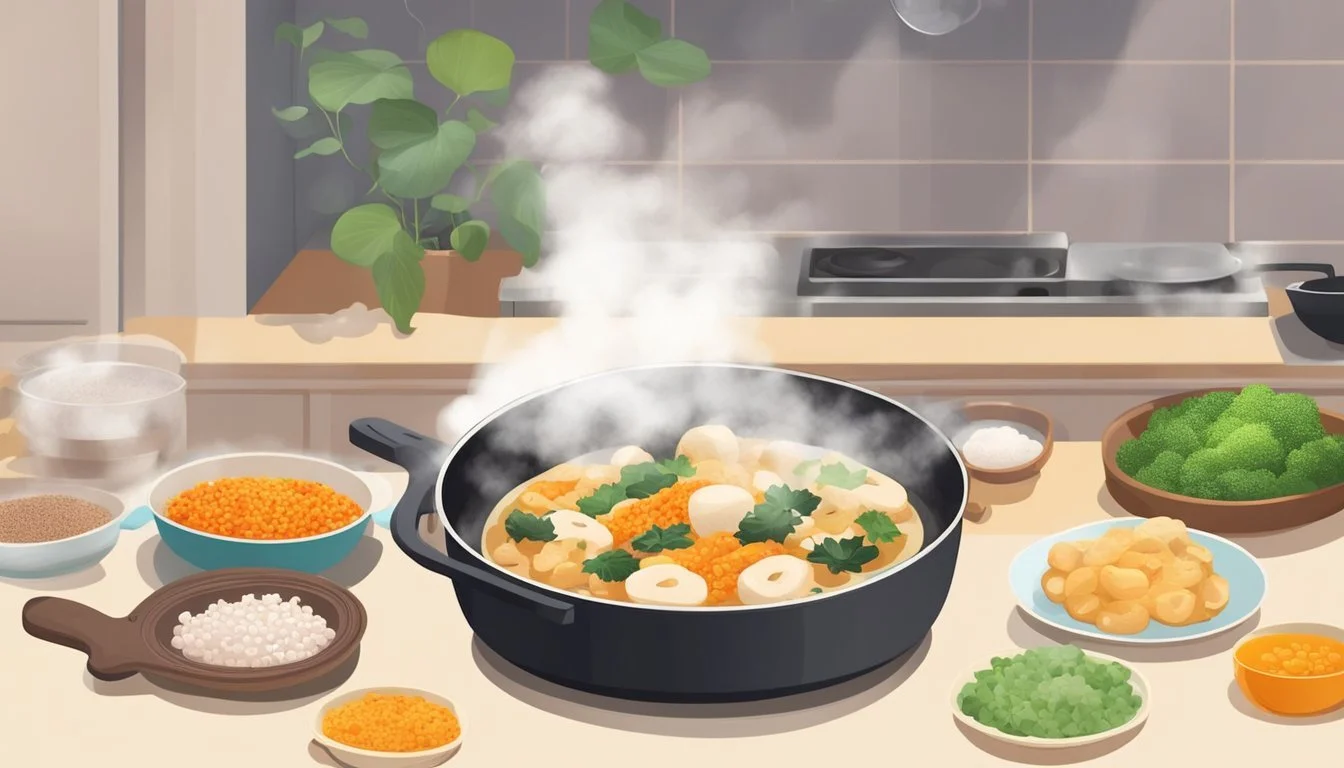Pickled Lotus Root Substitutes
Top Alternatives for Your Recipes
Pickled lotus root (renkon) is a cherished ingredient in Japanese cooking, offering a unique texture and slightly sweet, tangy flavor to dishes. For those looking to replicate its distinct qualities, several substitutes can be used effectively. Burdock root, a staple in Japanese cuisine, serves as an excellent alternative due to its similar texture and compatibility with pickling. It is traditionally used in stews and stir-fried dishes, making it a versatile replacement.
Another suitable substitute is jicama, which provides a crunchy texture and can absorb flavors well, much like lotus root. While it doesn't have the same historical ties to Japan, its adaptability makes it a practical stand-in. Additionally, salsify, often referred to as "oyster plant," can mimic the slightly briny taste of pickled lotus root, complementing a variety of Japanese dishes.
Incorporating these alternatives allows for a seamless transition in recipes that call for pickled lotus root, ensuring the integrity of flavor and experience. Whether you're making a traditional dish or experimenting with new flavors, these substitutes provide flexibility without compromising on authenticity.
Understanding Lotus Root
Lotus root is an essential ingredient in many Asian cuisines, particularly in Japan, due to its unique texture, nutritional benefits, and symbolic significance. This section explores its cultural importance, nutritional values, culinary versatility, as well as tips on selection and preparation.
Cultural Significance in Japan
In Japan, lotus root is known as renkon. It holds a special place in Japanese culture, not just as a food item but as a symbol of enlightenment and purity in Buddhism.
Lotus root is commonly included in celebrations such as New Year's dishes (osechi ryori). The holes in the lotus root slices symbolize an unobstructed view of the future, making it a traditional and auspicious ingredient.
Nutritional Profile
Lotus root is both healthy and nutritious. Rich in dietary fiber, it aids in digestion and promotes bowel health. It is also a good source of vitamin C, which helps with the immune system and skin health.
Additionally, it contains significant amounts of potassium, essential for heart health, as well as inulin and iron, which contribute to its health benefits. This makes it a valuable addition to a balanced diet.
Culinary Uses
Lotus root's crunchy texture and slightly sweet flavor make it versatile in the kitchen. It can be boiled, baked, fried, or pickled. In Japanese cuisine, it is often used in stews, soups, and stir-fried dishes.
It is also popular in its pickled form, adding a tangy flavor to meals. Fresh lotus root is suitable for tempura, while peeled and sliced it can be added to salads for a crisp bite.
Selection and Preparation
When selecting lotus root, look for firm, smooth rhizomes without soft spots or blemishes. The skin should be beige, not dry or cracked. Freshness is key as lotus root can quickly oxidize once peeled.
Preparation involves peeling the stem and slicing it. To prevent discoloration, immerse the slices in a bowl of water with a splash of vinegar. Proper preparation ensures the best texture and taste for culinary uses.
Pickled Lotus Root Overview
Pickled lotus root, or Su Renkon, combines the crisp texture of lotus root with a sweet and tangy marinade. It's a beloved side dish in Japanese cuisine, particularly during New Year celebrations.
Traditional Pickling Techniques
Traditional pickling techniques for lotus root involve marinating thinly sliced lotus root in a mixture of rice vinegar, sugar, salt, and mirin. These ingredients create a balance of sweet and sour flavors.
The process often starts with blanching the lotus root slices to maintain their crispness. They are then immersed in the vinegar-based marinade. Kombu, a type of seaweed, may be added to enhance flavor. An otoshibuta (drop lid) helps ensure even marination.
Popular Pickled Lotus Recipes
Popular recipes for pickled lotus root vary, but key ingredients remain consistent. One such recipe includes Namiko Chen's version from "Just One Cookbook," where lotus roots are marinated with rice vinegar, sugar, mirin, salt, and red chili pepper for a bit of heat.
Another common recipe involves adding sliced kombu to deepen the umami profile. These variations highlight how the basic pickling technique can be adapted for different flavor preferences, while still maintaining the dish's signature crisp texture and tangy taste.
Substitutes for Pickled Lotus Root
When looking for substitutes for pickled lotus root, factors to consider include texture, flavor, and suitable vegetable alternatives.
Substitutes Based on Texture
Burdock Root: This root vegetable has a similar crunchy texture to lotus root, making it a great substitute. It can be boiled, baked, or fried, and is commonly used in Japanese stews and stir-fries. Pickled burdock root retains a satisfying crunch.
Jicama: Known for its juicy and crispy texture, jicama comes close to replicating the crunchiness of pickled lotus root. It is best used raw or lightly cooked, making it ideal for salads and fresh dishes.
Daikon Radish: Daikon radish, when pickled, achieves a crispness that is similar to pickled lotus root. It has a uniquely firm texture that holds up well in pickling solutions, maintaining its integrity.
Substitutes Based on Flavor
Pickled Burdock Root: With its earthy undertones and slight sweetness, pickled burdock root can mimic the flavor profile of pickled lotus root. The vinegar and subtle peppery notes in pickling liquid can enhance its taste further.
Pickled Daikon Radish: This substitute offers a mild but slightly spicy flavor that complements the tangy vinegar used in pickling. Its flavor can be adjusted with additional seasonings like sugar or salt to closely match pickled lotus root.
Pickled Turnips: These root vegetables, when pickled, take on a tangy flavor that works well as a substitute. The combination of vinegar and spices can create a taste profile similar to that of pickled lotus root.
Vegetable Substitutes
Carrots: Thinly sliced and pickled carrots provide a sweet and slightly crunchy alternative to pickled lotus root. Their vibrant color can also add visual appeal to dishes.
Cucumber: When pickled, cucumbers offer a light and refreshing crunch. They absorb the flavors of the pickling brine well, making them a versatile substitute for pickled lotus root.
Bell Peppers: Pickled bell peppers bring a sweet and tangy flavor along with a tender yet firm texture. They can be julienned to replicate the sliced appearance of lotus root in pickled dishes.
These substitutes offer various textures and flavors while maintaining the essential characteristics of pickled lotus root.
Cooking with Lotus Root Substitutes
When looking to substitute lotus root in various cooking methods, there are several viable alternatives that retain the desired textures and absorb flavors well. These substitutes can be utilized in dishes ranging from stir-fries to deep-fried snacks and even in boiled or steamed recipes.
Stir-Frying Alternatives
Burdock Root is an excellent substitute for lotus root in stir-fry dishes like kinpira renkon. It can be sliced thin and used in Japanese stews or stir-fried dishes, maintaining a crunchy texture.
Jicama works well due to its crisp texture. It absorbs flavors from sauces while staying crunchy when quickly stir-fried with ingredients like soy sauce and mirin.
Water Chestnuts offer a sweet and crunchy texture similar to lotus root. They are best sliced thin and added towards the end to preserve their crunch in stir-fries.
Deep-Frying Alternatives
Taro Root can replace lotus root for deep-fried dishes like renkon chips. It has a starchy texture that crisps up well when deep-fried. Thin slices should be pre-soaked to remove excess starch and then fried until golden brown.
Sweet Potatoes are another option, particularly for making crispy snacks. Their natural sweetness pairs well with savory seasonings and they can be prepared in a similar manner, resulting in crunchy chips.
Yucca Root can be used for its starchy texture, mimicking the mouthfeel of deep-fried lotus root. Thinly slicing and frying yucca results in a crispy, crunchy snack that's great for dips or as a side.
Boiling and Steaming Alternatives
Burdock Root is suitable for dishes like chikuzenni, providing a firm texture that holds up well to boiling and steaming. It adds a depth of flavor and a slightly earthy taste to the dish.
Parsnips offer a sweet flavor and firm texture. They can be sliced and boiled or steamed until tender, making them a great alternative in recipes requiring lotus root.
Daikon Radish is especially useful in soups and stews. When boiled or steamed, it becomes tender yet retains a slight crunch, fitting well into dishes that traditionally use lotus root.
Seasoning and Flavor Pairings
When choosing seasonings and flavor pairings for pickled lotus root, it's essential to enhance its natural crispness and subtle taste. The right spices, herbs, and condiments can transform the lotus root into a delightful dish.
Pairing with Spices and Herbs
Spices and herbs play a crucial role in bringing out the best in pickled lotus root. Salt and pepper are basic essentials, providing foundational seasoning. Ginger adds a sharp, zesty kick that pairs well with the vinegar typically used in pickling.
For a hint of umami, miso can be lightly brushed on the lotus root slices before pickling. Sesame seeds create a pleasant crunch and pair excellently with the root's texture. When looking to add heat, Japanese karashi hot mustard offers a mustardy zip that complements the pickled flavor.
Soy sauce can also be incorporated to imbue an additional depth of savoriness. This combination of spices and herbs creates balanced flavors that excite the palate without overwhelming the lotus root's delicacy.
Accompaniments and Condiments
Incorporating accompaniments and condiments enhances the overall experience of pickled lotus root. Soy sauce serves as an excellent dipping option, adding umami and seasoning. Japanese karashi hot mustard provides a spicy contrast, perfect for those who enjoy a bit of heat.
Pickled lotus root pairs well with miso-based dips, introducing a complex, savory layer. For added texture and flavor, a sprinkle of sesame seeds can elevate the dish. Ginger slices can be served alongside for a fresh and spicy bite that cleanses the palate.
A splash of rice vinegar or a dash of sugar can subtlety tweak the flavor profile, ensuring the pickled lotus root remains versatile and exciting. These accompaniments and condiments not only enhance the taste but also complement the textural experience of the dish.
Storage and Preservation Tips
Proper storage and preservation of pickled lotus root substitutes ensure that their flavor and texture remain intact. This involves appropriate handling, temperature management, and using preservation techniques like refrigeration and freezing.
Keeping Substitutes Fresh
Refrigeration is essential to maintain the freshness of substitutes like burdock root and water chestnuts. Store these vegetables in a crisper drawer at a consistent temperature of 0-4°C (32-39°F).
Use airtight containers or zip-lock bags to prevent moisture loss and contamination. When storing at room temperature, keep them in a cool, dry place, away from direct sunlight. Ensure that the vegetables are clean and dry before storage to prolong their shelf life.
Preserving Substitutes for Long-term Use
Freezing is an effective method for long-term preservation. Slice the vegetables into uniform pieces, blanch them briefly, and then flash-freeze them on a baking sheet. Once frozen, transfer them to freezer-safe bags or containers, expelling as much air as possible to prevent freezer burn.
For a more flavorful preservation, marinate the substitutes in a mix of vinegar, sugar, and kombu dashi. This method adds complexity to the taste while ensuring longevity. Use an otoshibuta (drop lid) during the marination process to keep the vegetables submerged in the liquid fully.
Additional Serving Suggestions
Pickled lotus root offers versatility in culinary applications, making it a great addition to various dishes. It complements salads, enhances side dishes, and enriches soups and stews.
Incorporating into Salads
Adding pickled lotus root to salads introduces a crunchy texture and a mildly astringent taste. It pairs well with leafy greens, such as spinach or kale, and other crisp vegetables like cucumbers and bell peppers. The slices can be mixed with a light vinaigrette or Japanese sesame dressing. For an extra burst of flavor, combine it with ingredients like radishes, carrots, and edamame. Pickled lotus root is also excellent in Asian-inspired cold salads with tofu or grilled chicken, providing a delightful contrast to other soft or tender elements.
Creating Unique Side Dishes
Pickled lotus root can be featured in a variety of side dishes. It can be stir-fried with sesame oil, soy sauce, and a touch of mirin for a quick and tasty accompaniment to meals. Another option is to mix it with pickled burdock root for a vibrant and nutritious side. For a twist on traditional dishes, incorporate it into potato salads or coleslaw, where its unique texture and flavor can shine. Pickled lotus root can also be grilled lightly before serving, adding a smoky note that complements rice and grilled meats.
Use in Soups and Stews
Incorporating pickled lotus root into soups and stews adds depth and complexity to the dish. It is particularly effective in clear broths and miso-based soups, where it maintains its crispiness. Slice it thin and add towards the end of cooking to preserve its texture. In hearty stews, it can be combined with root vegetables like carrots, turnips, and daikon radish. For a fusion twist, consider adding it to Western-style vegetable soups or chicken stews, where it provides a unique and pleasant contrast. The astringent taste of pickled lotus root also cuts through rich, fatty flavors, balancing the overall profile of the dish.





